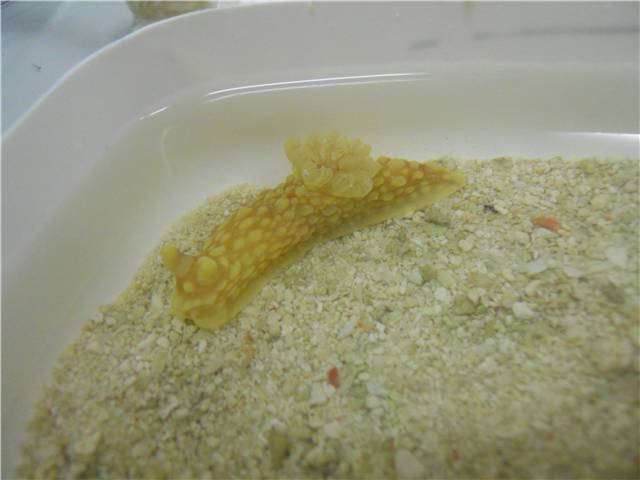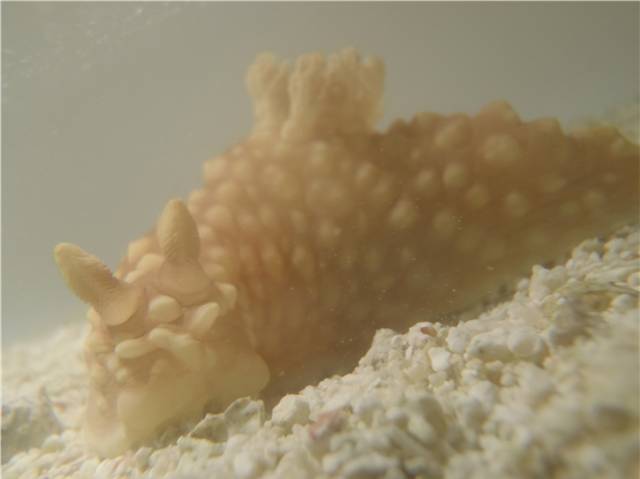Behaviour
Activity beha
viour (Focus topic)
Background

Major
ity of nud
ibranc
hs are known to be nocturnal, they burrow into sand
during the day and come out on the surface d
urin
g late afternoon
and night (Coleman 2008). They are also found under rocks or coral r
ubble which they use
as a shelter from sunlight and p
redation (Wells & Bryce 1993; Coleman 2000). Most Gymnodoridiadae species such as Gymnodoris striata (Nakano & Hirose 2011) are also describe
d a
s
sand dwellers during
day and become active at night to find food (Nakano & Hirose 2011). Gymnodoris species are predatory nudibranch and feedin
g on other smaller nudibanch species (Willian & Coleman 1984; Debelius & Kuiter 2007; Nakano & Hirose 2011). Prey nudibranchs are nocturnal so Gymnodoris come out on the surface to forage small sea slugs (Marshall & Willan 1999; Coleman 20
00).
However, Yellow-daubed Gymnodoris were found on the sand surface during the day. They were crawling on the sand around the coral rubble and rocks and could not be seen at night. The activity behaviour of this species has not fully described yet but Coleman (2000) reported that one yellow-daubed Gymnodoris was diurnally active. Although most nudibrachs are nocturnal, some species have diurnal rhythm so yellow-daubed Gymnodoris could be one of the species which is diurnal (Coleman 2000; Sea Slug Forum). Therefore, the hypothesis was built that yellow-daubed Gymnodoris move faster during the day than at night.
Material and Method
 Simple experiment was conducted to d
etermine if yellow-daubed Gymnodoris move faster during the day than at night. Fiveyello-daubed Gymnodoris were collected and used in this experiment. Each nudibranch was placed in the centre of the tray with sand and seawater. After releasing nudibranch in the tray, the time that nudibranch took to reach the wall of the tray was measured by stopwatch. Also, their tracks were traced by marking pen and clear acrylic board. The acrylic board was placed on the tray while nudibranch was walking
and the track was traced on the board. The image of each track was taken by camera and the images were analysed by ImageJ to get the distance of tracks. Each nudibranch has done the trial twice as a replication. For night trial, torch with covered by 787 Lee Filter was used to observe nudibranchs activity in the dark. This filter make
s red light (600 to 700 nm) (Lee Filter) which nudibranchs cannot detect so their activities were not disturbed by excess light (Coleman 2008).
The data was statistically analysed using one-way ANOVA by R software. The differences were considered either significant or insignificant with a significant level set up to p-value <0.05.
Result
Even though there was a trend that showed the walking speed in the day was slightly faster than in the night, the differences were not significant (p>0.05). The average walking speed during the night was 0.187 cm/s while the average speed in the day was 0.206 cm/s. The fastest speed was 0.293 cm/s and the slowest speed was 0.096 cm/s which were observed during the day time. The figure 1 shows the average walking speed in day and night.

Figure 1: The average walking speed of yellow-daubed Gymnodoris
( Gymnodoris spp.) in day and night.
Discussion
The result showed that the average walking speed of yellow-daubed Gymnodoris was slightly faster during the day than the night but the differences was not considered as significant (p>0.05). This finding does not support the hypothesis that yellow-daubed Gymnodoris move more active during the day than the night. The result indicated the walking speed of nudibranchs in the day was similar to in the night. According to Coleman (2008), some sand dweller nudibranchs can be seen on the surface during the early morning even though they are nocturnal. These nudibranchscome out on the surface of the sand with tide rising and forage food which are burrowing into the sandColeman 2008). The tide was not considered this experiment but the time when the nudibranchs were found was the transition of tide low to high. At the time, they were crawling on the sand surface. Therefore, it could be suggested that yellow-daubed Gymnodoris become active when tide is coming so they may change their activity behaviour depending on circatidal rhythm rather than day and night.
However, due to the fact that this was small simple study, the insignificant result might be due to limitations. Each yellow-daubed Gymnodoris was placed in the tray from the tank by hand. This transferring process would affect the nudibranchs activities. In addition, the experiment was conducted under the laboratory condition so the environment differences could be considered as the cause of disturbance of their activities.
Understanding the activity of yellow-daubed Gymnodoris is important because like other species of like other species of Gymnodorididae that are key predatory species to maintain the ecosystem (Nakano & Hirose 2011), this species might play an important role in the ecosystem as predator so conducting field observation to understand their activities is recommended.
Feeding behaviour
Species of Gymnodorididae are known to be predator on other smaller nudibrancks and/or their eggs (Well & Bryce 1993; Debelius 1998; Nakano & Hirose 2011). Gymnodoris nigricolor is the only species which is feeding on the tissue of the fins of goby fish Amblyeleotris japonica (Debelius & Kuiter 2007; Nakano & Hirose 2011). Except G. nigricolor, other Gymnodoris species never eat other organisms and eggs and each species has specific prey species (Nakano & Hrose 2011). Because of this feeding specific, the distribution of Gymnodorididae species and the activity are depending on the prey distribution (Nakano & Hirose 2011). distribution of Gymnodorididae species and the activity are depending on the prey distribution (Nakano & Hirose 2011).
They track the mucus trail of prey species and after reaching pray by oral tentacles, they eat prey in three different ways such as biting prey, swallowing whole prey and sucking the body fluid of prey (Debelius & Kuiter 2007; Nakano & Hirose 2011). They hunt other nudibranchs so they are quite active movers (Wells & Bryce 1993). As same as other nudibranchs, they contract their foot like wave backward in reverse to the direction the nudibranch is heading (Coleman 2008).
Apparently, the diet of yellow-daubed Gymnodoris is unknown (Marshall & Willan 1999; Coleman 2008), however, due to they are quite active and faster movers (observed in field and above experiment), they may be feeding on other nudibranch species as well.
|